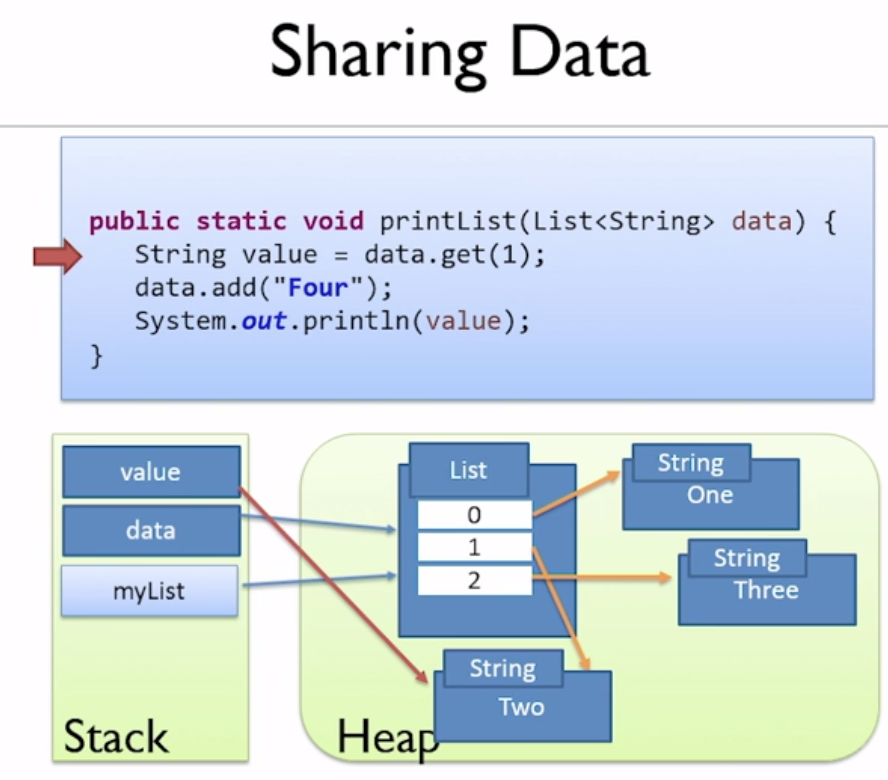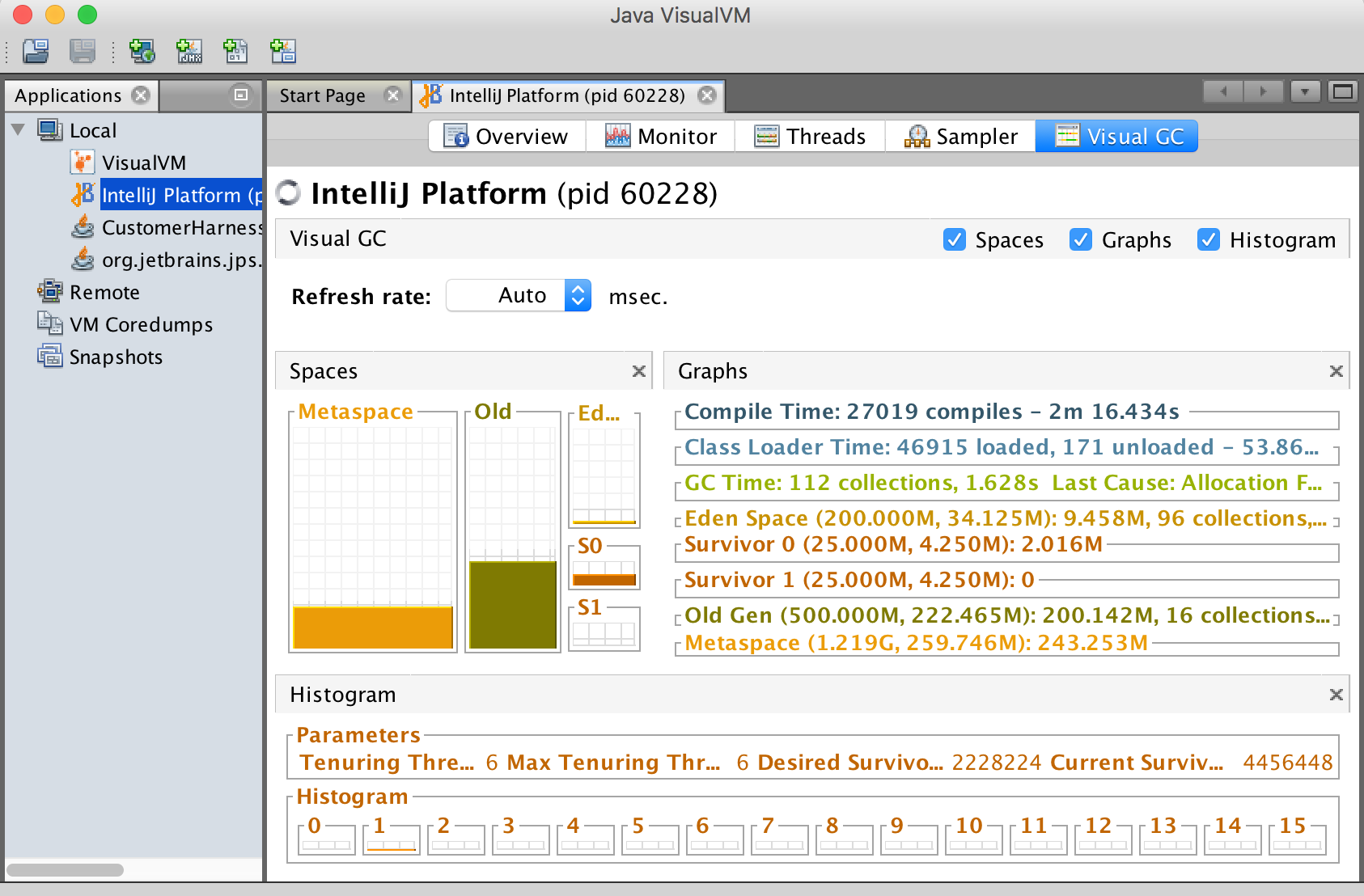Java Memory Management
How Memory works in Java
The role of the stack
- Each time you call a function, Java pushed the local variables for that function into the stack.
- When the method returns, all the data created on the stack for the method is popped or pulled from the stack.
- Whenever you reach a closing curly bracket, any local variables you declared inside the block that you're leaving is popped off the stack.
- Each thread has its own stack, so data on the stack can only be seen by the thread that owns the stack.

The role of the Heap
- All objects are stored on Heap, and shared across all threads.
- For the objects stored on the Heat there will be a pointer to the objects which is the variable reference stored on the stack.

Introduction to Garbage Collection
- String Pools
- Garbage Eligibility
Any objects on the Heap which cannot be reached through reference from the stack is eligible for GC.
- The gc() and finalize() methods
The gc() method suggests the JVM run GC process, but not guarantee that the JVM will do.
The finalize() method for the java.lang.object, this method is actually called by the gc. The gc might not run, so cannot rely on the finalize method being called.
Generational Garbage Collection
Mark and Sweep
- The general algorithm that GC use is called mark and sweep. It's a two stage process, the first stage is marking, and the second stage is sweeping.
- In the marking stage, the program's execution is first paused (stop the world event). It simply looks every variable in the stack and follows its reference, the object that it finds at the end of the reference is marked as being alive.
- In the sweeping stage, a full scan of the Heap take place, the memory occupied by the objects not marked of in use, can then be freed up. And finally, the objects are being kept are moved to a single continuous block of memory.
Using the Visual GC tool to view a soft leak
- Young generation (monor GC) VS. old generation (major GC)
- Can view these generations by the visual VM tool
a. $cd $JAVA_HOME/bin
b. $open jvisualvm
c. Need to install a plugin, go to the tools menu -> plugins -> available plugin tab -> select visual GC -> install. After finish install, close and reopen to see the new tab "Visual GC" should appear.
d. Go to the Monitor tab -> Heap Dump, will create Heap dump file for further analyzing.

Using the Memory Analyzer tool
a. Download MAT from eclipse.org/mat
b. Open the Heap dump file by MAT.
** Hit below error when start MAT on MAC:
See the log file
/Users/$USER/.eclipse/227783881_macosx_cocoa_x86_64/configuration/1554282657960.log
!ENTRY org.eclipse.osgi 4 0 2019-04-03 17:11:18.252
10 !MESSAGE Application error
11 !STACK 1
12 java.lang.IllegalStateException: The platform metadata area could not be written: /privat e/var/folders/cp/bnmgrhws25b_3272ly4zn0d00000gn/T/AppTranslocation/94A1F89C-EF58-45B4-A82 5-3D7DCEF5963D/d/mat.app/Contents/MacOS/workspace/.metadata. By default the platform wri tes its content
13 under the current working directory when the platform is launched. Use the -data parameter to
14 specify a different content area for the platform.
Solution:
$ vi mat.app/Contents/Eclipse/MemoryAnalyzer.ini
edit your MemoryAnalyzer.ini file, and add those lines (on two separate lines, and before the vm arguments), replacing the second with the path where you want the MemoryAnalyzer to write its content:
-data
<desired path of your working directory>
PermGen and the Metaspace
- In the Java 6, there is a further part of the Heap called PermGen. PermGen is nerver garbage-collected. There are two types of objects that go to PermGen, internized strings, and metadata for class.
- From Java 7, internized strings are no longer stored in PermGen, this change means that the internized strings are in the old part of the Heap, and can be garbage-collected.
- From Java 8, they removed the PermGen altogether, instead created something else called MetaSpace, which is where the class metadata are placed.
- The MetaSpace is a separate area of memory and it's not part of the Heap. Instead it's allocated out the host's native memory so the maximum available space for the MetaSpace is the total available system memory for the computer.
Tuning the Virtual Machine
Heap size
-Xmx, -Xms are non-standard argumants, so they are not guaranteed to be implemented on every runtime.
Please reference below page for the Java command line options.
https://docs.oracle.com/javase/8/docs/technotes/tools/windows/java.html
Garbage collection and generation sizes
-verbose:gc
-Xmn : set the size of the young generation
Choosing a garbage collector
- Serial : a single thread
- Parallel : multiple threads running.
- Mostly Concurrent: the stop-the-world part of the GC process is mimimized.
Java Memory Management的更多相关文章
- Java Memory Management(1)
Java Memory Management, with its built-in garbage collection, is one of the language’s finest achiev ...
- 转)Understanding Java Memory Management
Understanding Java Memory Management - IBM Java Native Interface (JNI) Objects and Code Java Native ...
- Java Memory Management Skill List
Java内存管理小技巧: 尽量使用直接量 当需要使用字符串,还有Byte,Short,Integer,Long,Float,Double,Boolean,Character包装类的实例时,程序不应该采 ...
- Java (JVM) Memory Model – Memory Management in Java
原文地址:http://www.journaldev.com/2856/java-jvm-memory-model-memory-management-in-java Understanding JV ...
- Understanding Java Memory Model-理解java内存模型(JVM)
from https://medium.com/platform-engineer/understanding-java-memory-model-1d0863f6d973 Understanding ...
- jmap命令(Java Memory Map)(转)
JDK内置工具使用 一.javah命令(C Header and Stub File Generator) 二.jps命令(Java Virtual Machine Process Status To ...
- Android内存管理(1)WRANGLING DALVIK: MEMORY MANAGEMENT IN ANDROID PART 1
from : http://www.raizlabs.com/dev/2014/03/wrangling-dalvik-memory-management-in-android-part-1-of-2 ...
- The Introduction of Java Memory Leaks
One of the most significant advantages of Java is its memory management. You simply create objects a ...
- Understanding Memory Management(2)
Understanding Memory Management Memory management is the process of allocating new objects and remov ...
随机推荐
- Intellij idea 离线安装activiti工作流插件
想在Intellij idea上安装一个activiti插件玩玩,由于网络环境原因,不能使用网上已有的在线搜索acti bpm并安装的方式.也在网上找了好久没找到离线安装的方式.自己摸索了一下装好了, ...
- 20170319 - pycurl 提示 libcurl link-time version is older than compile-time version
使用 conda update anaconda 升级后,运行程序得到如下提示: ImportError: pycurl: libcurl link-time version (7.45.0) is ...
- chrome谷歌浏览器开发者工具-网络带宽控制
有时候我们想在本地测试一下图片预加载loading的加载情况,如下图: 可无奈一般网络带宽都比较好,基本上看不到效果,图片一下子就加载出来了, 可能这个时候有些小伙伴想到的办法是用定时器延迟加载 其实 ...
- Tomcat的测试网页换成自己项目首页
<Host name="localhost" appBase="webapps" unpackWARs="true" autoDepl ...
- 一套代码小程序&Web&Native运行的探索06——组件系统
接上文:一套代码小程序&Web&Native运行的探索05——snabbdom 对应Git代码地址请见:https://github.com/yexiaochai/wxdemo/tre ...
- NodeJs之邮件(email)发送
NodeJs之邮件(email)发送 一,介绍与需求 1.1,介绍 1,Nodemailer简介 Nodemailer是一个简单易用的Node.js邮件发送插件 github地址 Nodemailer ...
- 2.1命令行和JSON的配置「深入浅出ASP.NET Core系列」
希望给你3-5分钟的碎片化学习,可能是坐地铁.等公交,积少成多,水滴石穿,谢谢关注. 命令行配置 1.新建控制台项目 2.nuget引入microsoft.aspnetcore.all 这里要注意版本 ...
- k8s数据管理(八)--技术流ken
volume 我们经常会说:容器和 Pod 是短暂的.其含义是它们的生命周期可能很短,会被频繁地销毁和创建.容器销毁时,保存在容器内部文件系统中的数据都会被清除. 为了持久化保存容器的数据,可以使用 ...
- c++性能测试工具:google benchmark入门(一)
如果你正在寻找一款c++性能测试工具,那么这篇文章是不容错过的. 市面上的benchmark工具或多或少存在一些使用上的不便,那么是否存在一个使用简便又功能强大的性能测试工具呢?答案是google/b ...
- PLSQL 登录出现 ora12638 credential retrieval failed
参考:http://blog.csdn.net/yjq8116/article/details/4203168 解决了 开始 -> 程序 -> Oracle -> Configura ...
